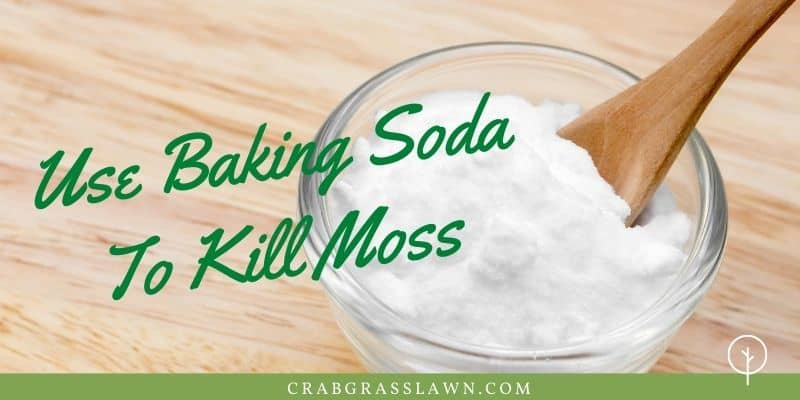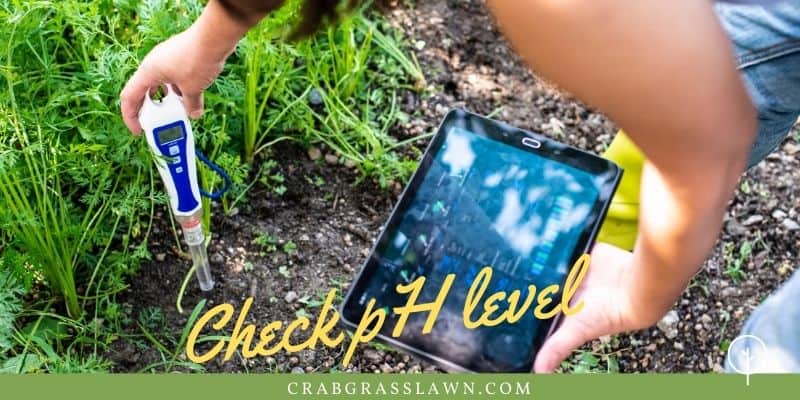Moss can be a beautiful, lush addition to your landscape i.e. if planted intentionally. However, having excess moss around indicates that you may have bigger problems such as poor drainage, compacted soil, not enough sunlight, or low soil pH.
I’ve tried several ways to get rid of moss naturally but the easiest way is with a mixture of 3 tablespoons of baking soda to 1 quart of water. Use gloves as you make this in a jug or spray bottle. Then apply to the moss and wait for the magic to happen.
Getting Rid Of Moss Naturally with Baking Soda – Easiest Way

The easiest and most efficient way of getting rid of moss is with plain old baking soda. This method is great for tackling smaller patches of moss or even crabgrass, and since it’s completely natural, it won’t hurt the environment or your garden plants, soil, or water.
Before getting started, it is recommended that you wear a pair of gloves when making the baking soda and water mixture to get rid of moss naturally. The best time to apply this natural moss-killing solution is in the afternoon when the grass is dry.
You can make the mixture as potent as you want depending on the density or quantity of moss, but the minimum is one tablespoon baking soda to one gallon of water. For small patches of moss, it’s best to start with three tablespoons of baking soda to one quart of water.
If you’re dealing with large patches of moss, then you will have to step it up a few notches with eight tablespoons of baking soda to one-quart water and sprinkle some baking soda over the affected area to enhance its effectiveness. Check-in a day or two, and repeat the process with a higher mixture potency or rake and discard the dead moss appropriately.
This is a temporary solution, and you will have to do it frequently, somewhere between two and three times a week. If you’re wondering how baking soda gets rid of moss, it increases the pH to a level that is inhospitable to moss.
Check your Soil’s pH

Two aspects play a pivotal role in helping moss reside in your lawn freely — your yard is shadier or the pH level of your soil is lower than optimum for grasses to thrive. There are several ways to get a reading of your soil’s pH level, but the most accurate is with a multifaceted soil meter.
Soils with pH values of 6.5 to 7.5 are considered neutral. alkaline over 7.5, acidic when less than 6.5, and strongly acidic when pH is less than 5.5. You can raise the pH level of your soil by applying lime to your lawn. Lime will not kill your grass, but when used properly will correct the imbalance of acidity in your soil to help it reach its optimum pH level.
See also my article on the signs your lawn needs lime
The best time to apply lime to your soil is between fall and spring, where fall is the better option, as rain and snow help lime break down and get to work. Using traditional lime can take months to show any significant results, but pelletized lime will begin to correct the soil pH almost immediately.
The most easiest and effective way of applying lime to your lawn is with the help of a lawn spreader. Once you’ve applied the lime, water your lawn to let the lime get to work.
Final Thoughts
Apart from the two natural moss removal solutions mentioned on this list, there are myriad others that you can try out if they fail.
However, it is highly recommended that you steer of chemical moss killers such as herbicides as they can be hazardous to you, and your family, and only have short-term effects on moss. Needless to say, you will still have to remove the moss physically even after using a chemical treatment.
Once you’ve determined the best solution to get rid of moss naturally in your lawn, you should also take the necessary steps to prevent its return. The best preventive measure is to considerably reduce the conditions favored by moss.
For example, you should maintain your soil’s pH level between 6 and 7, which is not moss-friendly. Next, you should allow the soil to dry before watering it, which is ideally in the late afternoon. Another way to prevent moss growth naturally is to reduce the amount of shade on the moss growth areas such as by trimming tree branches.
Hi, Alex Kuritz here. Growing up I remember that my family had one of the best lawns in the neighborhood. Richly green and lush. I did a lot as I grew up in terms of caring and tending for not only my family’s lawn but also my neighbors. I can say I have years of experience, and I am here to share it with you.


